Abstract
This study investigated the effect of exercise duration on the response dynamics of oxygen consumptionVO2, carbon dioxide outputVCO2, ventilation VE), and cardiac frequency (f c) following stepped changes in exercise intensity, by manipulating the duration of the pretransition exercise period. A group of 11 healthy men performed a stepped exercise intensity cycling protocol on three separate occasions, each consisting of a stepped increase from 55% to 65% peak oxygen consumptionVO2,peak of 6-min duration, followed by a stepped decrease to 55%VO2,peak of 10-min duration. This stepped protocol was preceded by either 5, 15, or 60 min of cycling at 55%VO2,peak. The response times for each variable were calculated at 10% increments between the prestep baselines and poststep plateaux. Following the stepped increase, the response times forVO2 at the 50%, 60%, 70%, 80%, and 90% relative increments were significantly reduced in the 60-min condition compared to the 15-min condition (P< 0.05); however, the response times forVCO2 andf c were not significantly altered across the three conditions. No significant differences were found in the response times forVO2,VCO2 andf c, across the three conditions following the stepped decrease in exercise intensity. It was concluded that the faster response time of aerobic metabolism to a stepped increase in exercise intensity was mediated by increases in active muscle temperature, leading to improved oxygen utilisation.
Similar content being viewed by others
References
Ahlborg G, Felig P (1982) Lactate and glucose exchange across the forearm, legs, and splanchnic bed during and after prolonged leg exercise. J Clin Invest 69:45–54
Casaburi R, Barstow T, Robinson T, Wasserman K (1989) Influence of workrate on ventilatory and gas exchange kinetics. J Appl Physiol 67:547–555
Diamond L, Casaburi R, Wasserman K, Whipp B (1977) Kinetics of gas exchange and ventilation in transitions from rest or prior exercise. J Appl Physiol 43:704–708
Di Prampero P, Mahler P, Giezendanner D, Cerretelli P (1989) Effects of priming exercise onVO2 kinetics and O2 deficit at the onset of stepping and cycling. J Appl Physiol 66:2023–2031
Ekelund L, Holmgren A (1964) Circulatory and respiratory adaptation during long-term non-steady state exercise in the sitting position. Acta Physiol Scand 61:240–255
Farhi L, Rahn H (1955) Gas stores of the body and the unsteady state. J Appl Physiol 7:472–484
Fox E, Bowers R, Foss M (1989) The physiological basis of physical education and athletics, 4th edn. Brown, Dubuque, Iowa
Gaesser GA, Brooks GA (1984) Metabolic bases of excess postexercise oxygen consumption: a review. Med Sci Sport Exerc 16:29–43
Hagberg J, Hickson R, McLane J, Ehsani A, Winder W (1979) Disappearance of norepinephrine from circulation following strenuous exercise. J Appl Physiol 47:1311–1314
Hagberg J, Hickson R, Ehsani A, Holloszy J (1980a) Faster adjustment to and recovery from submaximal exercise in the trained state. J Appl Physiol 48:218–224
Hagberg J, Mullin J, Nagel F (1980b) Effect of work intensity and duration on recovery O2. J Appl Physiol 48:549–544
Hill A, Lupton H (1923) Muscular exercise, lactic acid and the supply and utilisation of oxygen. Q J Med 16:135–171
Hughson R, Morrissey M (1983) Delayed kinetics of 428-1 in the transition from prior exercise. Evidence for O2 transport limitation ofVO2 kinetics: a review. Int J Sports Med 4:31–39
Hughson R, Inman M (1986) Faster kinetics ofVO2 during arm exercise with circulatory ecclusion of the legs. Int J Sports Med 7:22–25
Hughson R, Sherrill D, Swanson G (1988) Kinetics ofVO2 with impulse and step exercise in humans. J Appl Physiol 64:451–459
Kinderman W, Schnabel A, Schmitt W, Biro G, Cassens J, Weber F (1982) Catecholamines, growth hormone, cortisol, insulin, and sex hormones in anaerobic and aerobic exercise. Eur J Appl Physiol 49:389–399
Kjaer M (1989) Epinephrine and some other hormonal responses to exercise in man; with special reference to physical training. Int J Sports Med 10:2–15
Lehninger A (1975) Biochemistry, 2nd edn. The molecular basis of cell structure and function. Worth, New York
Linnarsson D (1974) Dynamics of pulmonary gas exchange and heart rates at the start and end of exercise. Acta Physiol Scand [Suppl] 415:1–68
Margaria R, Edwards H, Dill D (1933) The possible mechanisms of contracting and paying the oxygen debt and the role of lactic acid in muscular contraction. Am J Physiol 106:689–715
Miyamoto Y, Hiura T, Tamura T, Nakamura T, Higuchi J, Mikami T (1982) Dynamics of cardiac, respiratory, and metabolic function in men in response to step work load. J Appl Physiol 52:1198–1208
Mole P, Coulson R (1985) Energetics of myocardial function. Med Sci Sport Exerc 17:538–545
Nagel F, Robinhold D, Howley E, Daniels J, Baptista G, Stoedefalke K (1970) Lactic acid accumulation during running at submaximal aerobic demands. Med Sci Sports 2:182–186
Osbourne M, Mackenzie I, Taylor N (1994) Effect of altered haematocrit and inspired oxygen tension on respiratory gas exchange dynamics during submaximal exercise. Proc Aust Physiol Pharmacol Soc 25:9P
Pendergast D, Shindell D, Cerretelli P, Rennie D (1980) Role of the central and peripheral circulatory adjustments in oxygen transport at the onset of exercise. Int J Sports Med 1:160–170
Powers S, Dodd S, Beadle R (1985) Oxygen uptake kinetics in trained athletes differing in 428-5. Eur J Appl Physiol 54:306–308
Raynaud J, Bernal H, Bourdarias J, David P, Durand J (1973) Oxygen delivery and oxygen return to the lungs at the onset of exercise. J Appl Physiol 35:259–262
Rowell L (1977) Competition between skin and muscle for blood flow during exercise. In: Nadel E (ed) Problems with temperature regulation during exercise. Academic Press, New York, pp 49–76
Salhin K, Ren J, Broberg S (1988) Oxygen deficit at onset of submaximal exercise is not due to delayed oxygen transport. Acta Physiol Scand 134:175–181
Saltin B, Hermansen L (1966) Esophageal, rectal and muscle temperature during exercise. J Appl Physiol 21:1757–1762
Savard G, Nielsen B, Laszczynska J, Larsen B, Saltin B (1988) Muscle blood flow is not reduced in humans during moderate exercise and heat stress. J Appl Physiol 64:649–657
Shaffrath J, Adams W (1984) Effects of airflow and workload on cardiovascular drift and skin blood flow. J Appl Physiol 56:1411–1417
Solomon C (1991) The effects of exercise duration respiratory gas exchange, ventilation, and heart rate dynamics. Thesis, University of Wollongong, Australia
Solomon C (1993) Arterial haemoglobin oxygen saturation and pulmonary ventilation during incremental and interval exercise. Proc Aust Physiol Pharmacol Soc 24:77P
Terjung R, Winder W (1975) Exercise and thyroid function. Med Sci Sport Exerc 7:20–26
Whipp B, Wasserman K (1972) Oxygen uptake kinetics for various intensities of constant load work. J Appl Physiol 33:351–356
Whipp B, Ward S, Lamarra N, Davis J, Wasserman K (1982) Parameters of ventilatory and gas exchange dynamics during exercise. J Appl Physiol 52:1506–1513
Author information
Authors and Affiliations
Rights and permissions
About this article
Cite this article
Solomon, C., Taylor, N.A.S. The effects of exercise duration on dynamics of respiratory gas exchange, ventilation, and heart rate. Europ. J. Appl. Physiol. 69, 421–428 (1994). https://doi.org/10.1007/BF00865406
Accepted:
Issue Date:
DOI: https://doi.org/10.1007/BF00865406




